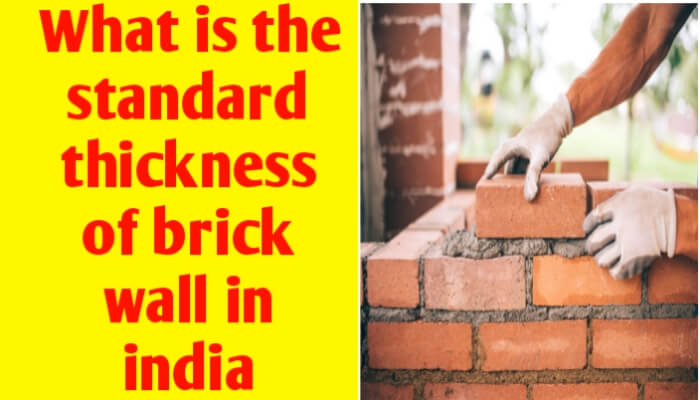The standard thickness of a brick wall in India can vary based on the type of wall and its intended purpose. For example, a common thickness for a load-bearing brick wall is 230 mm (9 inches), while non-load-bearing walls might have a thickness of 115 mm (4.5 inches).
It is a fact that average thickness of wall in house is decided with well planed architecture engineering and made with required or minimum thickness of wall which should be sufficient to cover of all projection of beam and pillar and comfortable living inside each room of house.

Well planned house of single storey consist of different rooms like kitchen, guest room, bedroom and others, standard wall thickness in a house is depending upon location of the house, climatic condition of environment or it varies from country to country as per their local house bye-laws and regulation of Municipal authority.
◆You Can Follow me on Facebook and Subscribe our Youtube Channel
You should also visits:-
1)what is concrete and its types and properties
2) concrete quantity calculation for staircase and its formula
However, if there is no any significant rule to follow contractors and development by public and private sector tend to reduce the size of dwellings being developed. Bye-law of local Municipal authority for minimum wall thickness in a house and room size standards allows well planned and systematic construction of residential house and towns, and that provide proper utilization of space.
In this article we explain what is the standard thickness of brick wall in India | wall thickness in mm | wall thickness in feet | wall thickness in metres | wall thickness in inches | wall thickness in cm.
What is the standard thickness of brick wall in India
In india, for wall construction inside house there is several building material are used like red clay brick, stone, AAC Block, concrete block and RCC outer wall. If we are using brick for wall construction, minimum thickness of brick wall should be kept around 9 inch (230mm) thick for outer wall, 4.5 inch (115mm) thick for internal wall partition and 3 inch (80mm) thick for cupboard and railing purpose, because of a standard brick size available in 9″ × 4.5″ ×3″ (230mm × 115mm× 75mm).
In india, If we are adopting AAC Block and concrete block in place of red clay brick, for wall construction for residential/ commercial building, standard wall thickness should be kept around 8 inch (200mm) thick for outer wall and 4 inch (100mm) thick for inner wall partition.
In india, If we are adopting RCC wall, load bearing structure in place of AAC Block, concrete block and red clay brick, for wall construction for residential/ commercial building, standard wall thickness should be kept around 6 inch (150mm) thick for outer wall and 3 inch (80mm) thick for inner wall partition.

In India, for house construction of residential/ commercial building, standard thickness of brick wall should be kept around 9 inch (230mm) thick for outer wall, 4.5 inch (120mm) thick for internal wall partition and 3 inch (80mm) thick for cupboard and railling purpose.
Wall thickness in mm
Wall thickness in mm:- we are using brick for wall construction, then minimum wall thickness should be kept around 230mm thick for outer wall, 120mm thick for internal wall partition and 80mm thick for cupboard and railling purpose. If we are adopting AAC block and concrete block then minimum wall thickness should be reduced around 200mm thick for outer wall and 100mm for inner wall partition. If adapting RCC outer wall, thickness can be reduced 150mm.
Wall thickness in inches
Wall thickness in inches:- we are using brick for wall construction, then minimum wall thickness should be kept around 9 inch thick for outer wall, 4.5 thick for internal wall partition and 3 inch thick for cupboard and railling purpose. If we are adopting AAC block and concrete block then minimum wall thickness should be reduced around 8 inch thick for outer wall and 4 inch for inner wall partition. If adapting RCC outer wall, thickness can be reduced 6 inch.
Wall thickness in cm
Wall thickness in cm:- we are using brick for wall construction, then minimum wall thickness should be kept around 23cm thick for outer wall, 12cm thick for internal wall partition and 8cm thick for cupboard and railling purpose. If we are adopting AAC block and concrete block then minimum wall thickness should be reduced around 20cm thick for outer wall and 10cm for inner wall partition. If adapting RCC outer wall, thickness can be reduced 15cm.
Wall thickness in meters/ m
Wall thickness in meters:- we are using brick for wall construction, then minimum wall thickness should be kept around 0.230m thick for outer wall, 0.120m thick for internal wall partition and 0.080m thick for cupboard and railling purpose. If we are adopting AAC block and concrete block then minimum wall thickness should be reduced around 0.200m thick for outer wall and 0.10m for inner wall partition. If adapting RCC outer wall, thickness can be reduced 0.150m.
Wall thickness for building with RCC framed structure
For all type Building with RCC frame structure, for non load bearing wall, minimum required wall thickness should be 8 inch (200mm) thick for outer wall and to reduce the cost, we can reduce the thickness to 4 inch (100mm) for interior wall partition in RCC frame structure.
ALSO READ :-
Standard width of road | standard Road Lane width
Standard pitch of roof in degrees, ratio & fraction for house
Standard size of 1BHK, 2BHK, 3BHK & 4BHK flat in India
Standard size of stairs for residential & commercial building
Standard size of window for residential building
Wall thickness for load bearing structure
For all type building, for load bearing structure, in brick masonry wall, thickness can be 300 mm to 450mm for outer wall of G+2 house and internal wall thickness can be 300mm to 200mm according to span and room size.
If we are using stone for load bearing wall, thickness can be 300 mm to 450 mm, 450mm for ground floor, 350mm for 1st floor and 300mm for 2nd floor.
In old building we can see brickwork is lime mortar of 450mm to 600mm thickness in ground floor and 300mm to 450mm in next 2nd and 3rd floor.